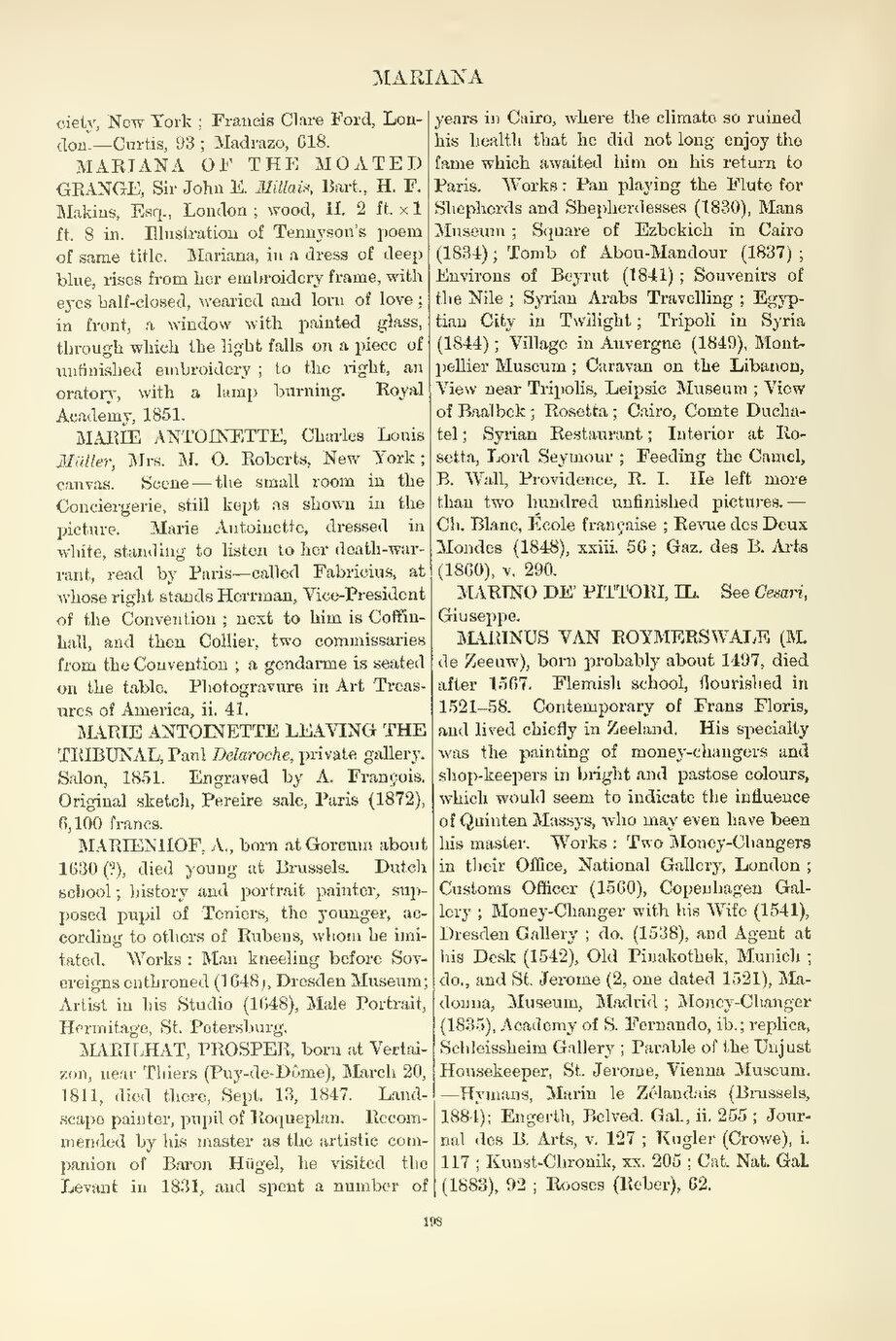- ciety, New York; Francis Clare Ford, London.—Curtis,
93; Madrazo, 618.
MARIANA OF THE MOATED
GRANGE, Sir John E. Millais, Bart., H. F.
Makins, Esq., London; wood, H. 2 ft. × 1
ft. 8 in. Illustration of Tennyson's poem
of same title. Mariana, in a dress of deep
blue, rises from her embroidery frame, with
eyes half-closed, wearied and lorn of love;
in front, a window with painted glass,
through which the light falls on a piece of
unfinished embroidery; to the right, an
oratory, with a lamp burning. Royal
Academy, 1851.
MARIE ANTOINETTE, Charles Louis
Müller, Mrs. M. O. Roberts, New York;
canvas. Scene—the small room in the
Conciergerie, still kept as shown in the
picture. Marie Antoinette, dressed in
white, standing to listen to her death-warrant,
read by Paris—called Fabricius, at
whose right stands Herrman, Vice-President
of the Convention; next to him is Coffinhall,
and then Collier, two commissaries
from the Convention; a gendarme is seated
on the table. Photogravure in Art Treasures
of America, ii. 41.
MARIE ANTOINETTE LEAVING THE
TRIBUNAL, Paul Delaroche, private gallery.
Salon, 1851. Engraved by A. François.
Original sketch, Pereire sale, Paris (1872),
6,100 francs.
MARIENHOF, A., born at Gorcum about
1630 (?), died young at Brussels. Dutch
school; history and portrait painter, supposed
pupil of Teniers, the younger, according
to others of Rubens, whom he imitated.
Works: Man kneeling before Sovereigns
enthroned (1648), Dresden Museum;
Artist in his Studio (1648), Male Portrait,
Hermitage, St. Petersburg.
MARILHAT, PROSPER, born at Vertaizon,
near Thiers (Puy-de-Dôme), March 20,
1811, died there, Sept. 13, 1847. Landscape
painter, pupil of Roqueplan. Recommended
by his master as the artistic companion
of Baron Hügel, he visited the
Levant in 1831, and spent a number of
years in Cairo, where the climate so ruined
his health that he did not long enjoy the
fame which awaited him on his return to
Paris. Works: Pan playing the Flute for
Shepherds and Shepherdesses (1830), Mans
Museum; Square of Ezbekieh in Cairo
(1834); Tomb of Abou-Mandour (1837);
Environs of Beyrut (1841); Souvenirs of
the Nile; Syrian Arabs Travelling; Egyptian
City in Twilight; Tripoli in Syria
(1844); Village in Auvergne (1849), Montpellier
Museum; Caravan on the Libanon,
View near Tripolis, Leipsic Museum; View
of Baalbek; Rosetta; Cairo, Comte Duchatel;
Syrian Restaurant; Interior at Rosetta,
Lord Seymour; Feeding the Camel,
B. Wall, Providence, R. I. He left more
than two hundred unfinished pictures.—Ch.
Blanc, École française; Revue des Deux
Mondes (1848), xxiii. 56; Gaz. des B. Arts
(1860), v. 290.
MARINO DE' PITTORI, IL. See Cesari,
Giuseppe.
MARINUS VAN ROYMERSWALE (M.
de Zeeuw), born probably about 1497, died
after 1567. Flemish school, flourished in
1521-58. Contemporary of Frans Floris,
and lived chiefly in Zeeland. His specialty
was the painting of money-changers and
shop-keepers in bright and pastose colours,
which would seem to indicate the influence
of Quinten Massys, who may even have been
his master. Works: Two Money-Changers
in their Office, National Gallery, London;
Customs Officer (1560), Copenhagen Gallery;
Money-Changer with his Wife (1541),
Dresden Gallery; do. (1538), and Agent at
his Desk (1542), Old Pinakothek, Munich;
do., and St. Jerome (2, one dated 1521), Madonna,
Museum, Madrid; Money-Changer
(1835), Academy of S. Fernando, ib.; replica,
Schleissheim Gallery; Parable of the Unjust
Housekeeper, St. Jerome, Vienna Museum.—Hymans,
Marin le Zélandais (Brussels,
1884); Engerth, Belved. Gal., ii. 255; Journal
des B. Arts, v. 127; Kugler (Crowe), i.
117; Kunst-Chronik, xx. 205; Cat. Nat. Gal.
(1883), 92; Rooses (Reber), 62.
